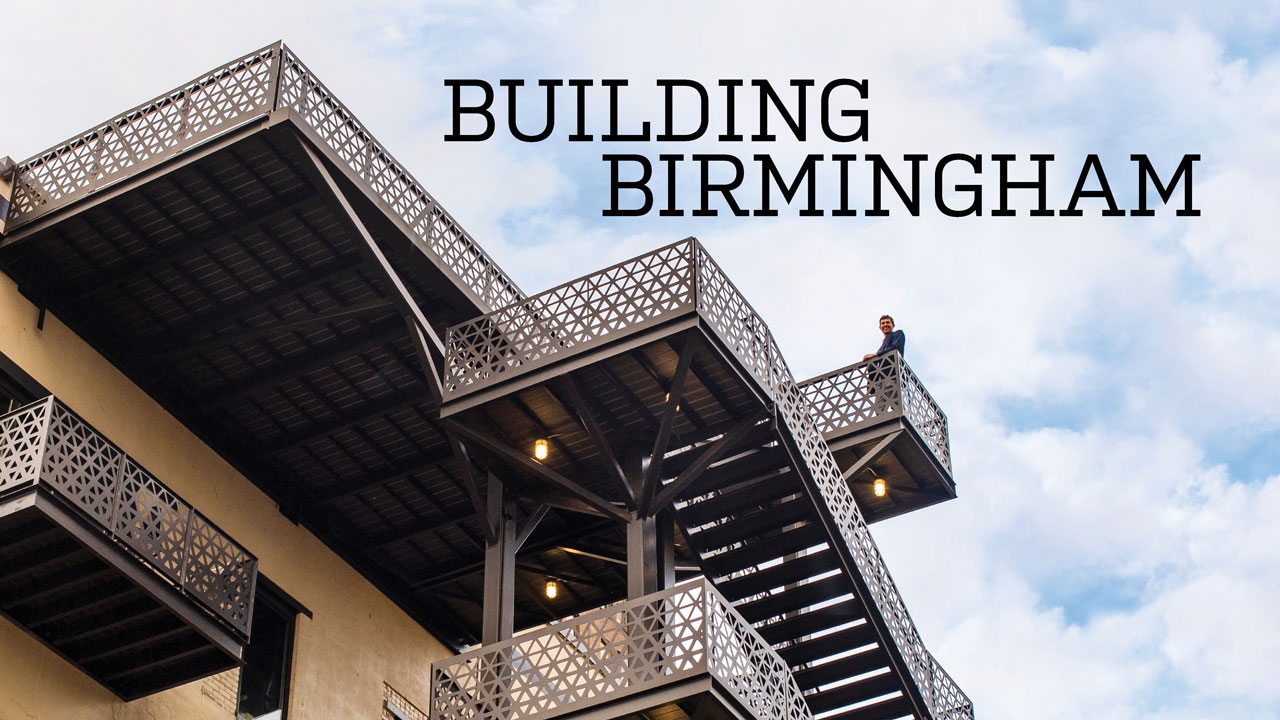Take a stroll around Birmingham today, and you’re bound to spot something new: once silent buildings converted into popular dining and entertainment destinations; weedy blocks transformed into sports venues filled with cheering fans; rediscovered streets that pulse with activity. Graduates of UAB’s School of Engineering have helped light the spark of revitalization by planning, managing, and laying the groundwork—sometimes literally—for structures that symbolize the city’s new spirit. And in doing so, they are forging legacies of their own. A few of these city-shapers describe some of their favorite projects:
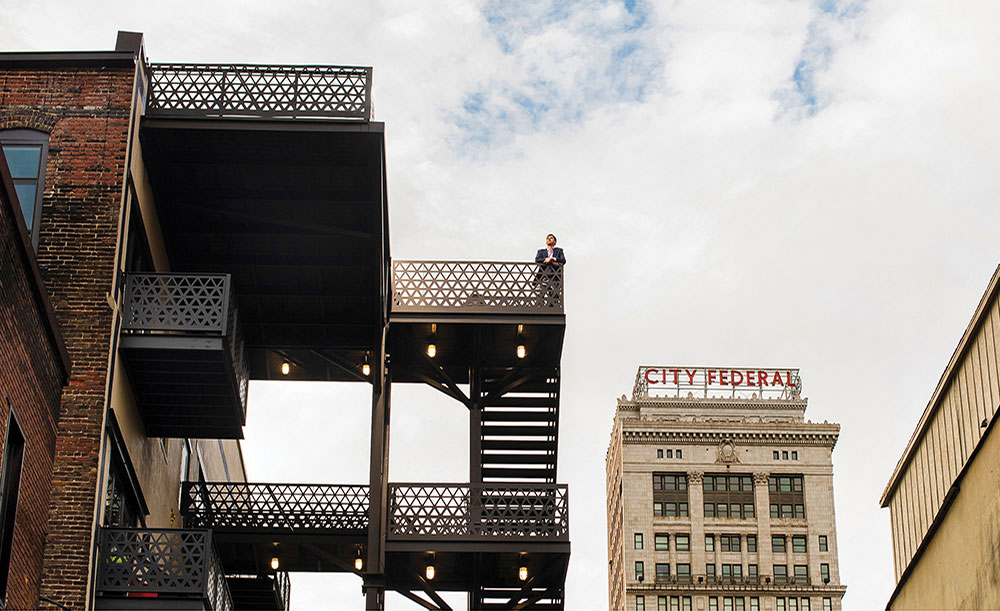 Hunter Renfroe at Founders Station
Hunter Renfroe at Founders Station
Polishing historic gems
As principal at Orchestra Partners, which he cofounded in 2015, Hunter Renfroe’s passion for real-estate development and love for his hometown have inspired projects designed to reinvigorate Birmingham neighborhoods. For example, Founders Station, which opened last year, fills some of downtown’s oldest buildings with restaurants, bars, retailers, offices, and residences. The complex is bringing new visitors to cobblestoned Morris Avenue, which Renfroe calls a “hidden gem.”
Closer to campus, The Woolworth reimagines a one-time dime store as a main attraction for Five Points South. Renfroe, who graduated in 2010 with a master’s in civil engineering, says his vision for the project speaks to the city’s need for spaces where diverse communities can mingle. “Five Points has always been a nice place to have dinner, but people usually valet their cars and leave right afterward,” he explains. “We wanted to create something where you have enough time and enough interface to get comfortable with the area and be willing to walk around and explore.” With a duckpin bowling alley, an arcade, food, and a rooftop bar, The Woolworth aims to “invite folks, both locally and from UAB, to mix with people over the mountain—to show suburbanites what the city has to offer.”
Renfroe enjoyed exploring Birmingham as a student. He credits UAB’s location with giving him opportunities to “interact with downtown and the architecture,” he says. “I could walk to class and around the city.” Now he’s helping other people do the same thing through the projects he chooses. Next on his company’s list: the redevelopment of the Frank Nelson Building, a 10-story downtown landmark built in 1903.
“UAB is the lifeblood of growth in Birmingham, and I want to do development that complements UAB,” he says.
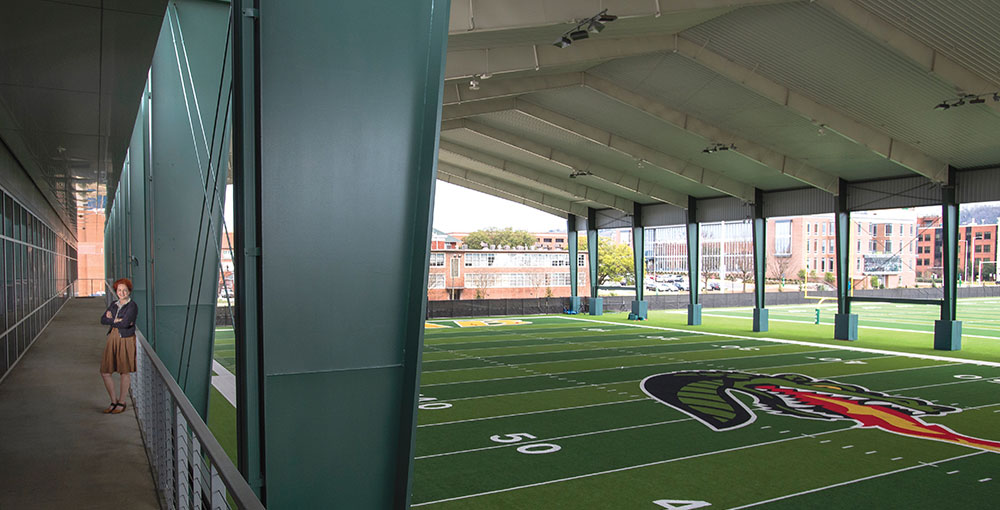 Liz Hyde at Legacy Pavilion at UAB's Football Operations Complex
Liz Hyde at Legacy Pavilion at UAB's Football Operations Complex
Powering a renaissance
Without Liz Hyde, president of Hyde Engineering, the Birmingham Crossplex and UAB’s Football Operations Complex would be left in the dark. The 1983 electrical engineering graduate and her team designed lighting, power, and fire alarm systems, among other projects, for the Crossplex. Their contributions to the Football Operations Complex, a key component of Blazer football’s renaissance, included exterior lighting and interior electrical design for the weight rooms. But the work went far beyond designing intricate networks of wires, plugs, and lights, she says. “We’re a fairly small company, so I wear a lot of hats,” she explains. “I do a lot of management. It’s a lot of multitasking: writing proposals, marketing, working on projects, working with clients, troubleshooting, etc.”
Hyde says she enjoys spotting the buildings her team has worked on as she rides around town. “The Crossplex and Football Operations Complex add a positive light to the city,” she says. “I like to think I’ve had a little part in doing things that mean something.”
Hyde became the first woman in the state to head an electrical engineering firm when she founded her company, she says. She attributes part of her success to the opportunities that UAB and Birmingham offer. “I had already been in school, but I was looking for a different location,” and UAB’s engineering school was a “premier program,” she explains. While there, Hyde sought out local internships that helped her gain career experience. She also appreciates the ways in which “Birmingham and UAB reach out to underserved minorities to give them a seat at the table,” she says. “I will always be thankful for that.”
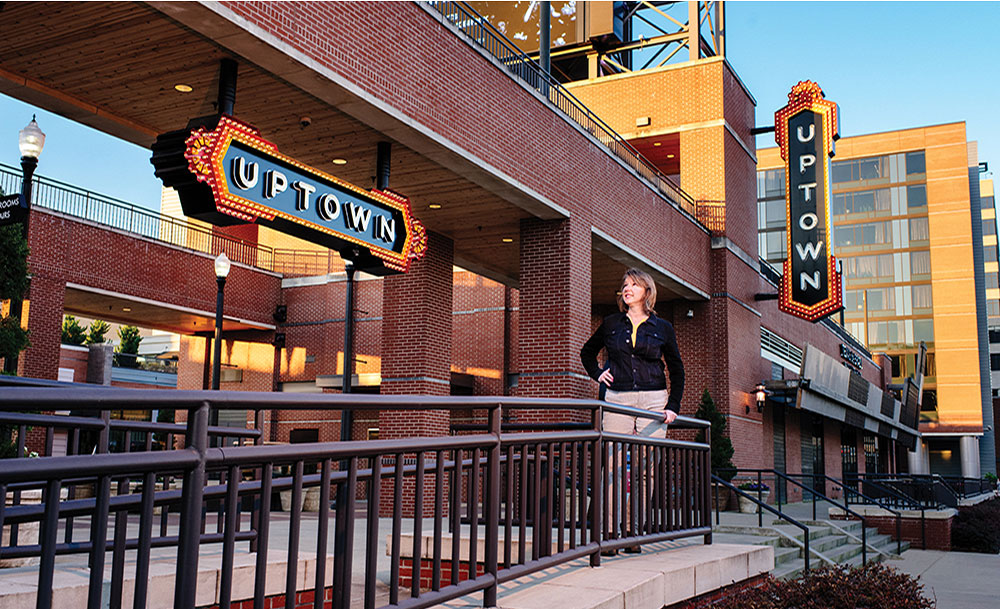 Shelia Montgomery Mills at the Uptown district at the Birmingham-Jefferson Convention Complex
Shelia Montgomery Mills at the Uptown district at the Birmingham-Jefferson Convention Complex
Building excitement
Shelia Montgomery Mills’s design work in Birmingham spans both miles and years. The Theater District, Vulcan Trail, and Avondale’s 41st Street all bear her fingerprints. Today, Mills works as a senior project manager with the Birmingham-Jefferson Convention Complex, where she coordinates tenant improvements for popular businesses such as TopGolf and Eugene’s Hot Chicken. She also holds a high-level role in planning upgrades for current facilities and developing new ones, among them the construction of Protective Stadium—Blazer football’s future home field—and renovations to Legacy Arena. “It is an exciting time to be in Birmingham and to do what I do,” she says.
Born in Birmingham, Mills has had a front-row seat to the area’s revival as a longtime resident in the downtown loft community. In 2013 she was appointed to the city’s Design Review Committee (DRC), which approves plans for new buildings and renovations in historic and commercial districts. “Serving on the DRC is my continued commitment to giving back to my community, my home,” she says.
Mills’s introduction to engineering came from an eighth-grade aptitude test that indicated she would be well-suited for the field. Convenient class schedules and her desire to stay close to home drew her to UAB, where she earned a 1992 civil engineering degree and, later, a master’s in business administration. Today she gives back to the School of Engineering by volunteering as a guest speaker, a judge for senior design projects, and a mentor for students looking to find their niche in the broad field of civil engineering. Mills encourages them to be innovative in their thinking. “I remind students that the problems of today and tomorrow can’t always be solved with the methods of the past,” she says. “I encourage them to understand the past, but to question if there’s a better way to do things.”
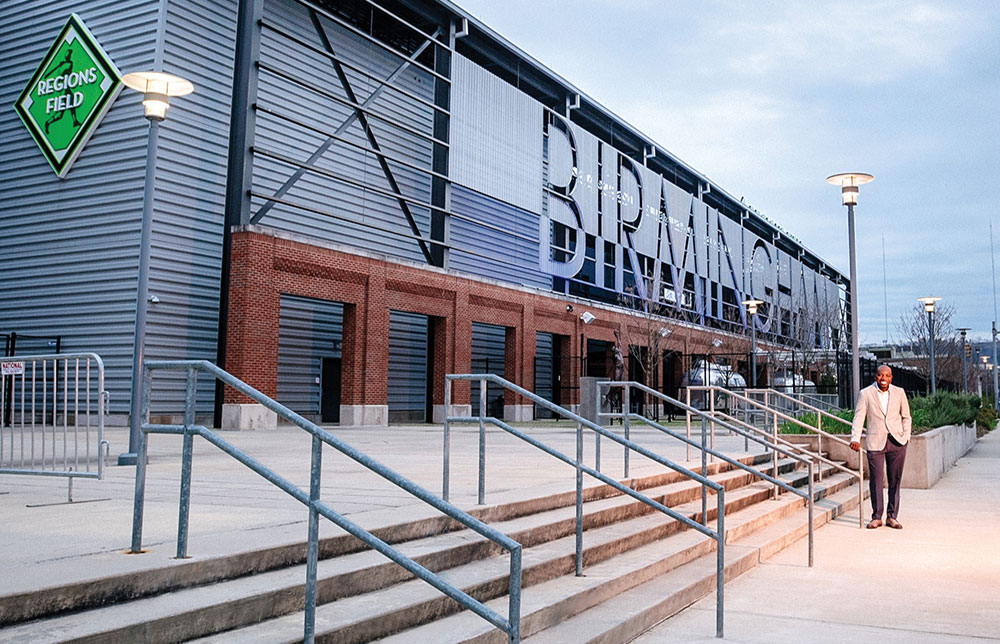 Bolaji Kukoyi at Regions Field
Bolaji Kukoyi at Regions Field
Perfecting the details
As president of Dynamic Civil Solutions, Bolaji Kukoyi helped bring Regions Field to life and restore Avondale Park as a neighborhood anchor. He also had a hand in some striking new buildings on UAB’s campus, including the Abroms-Engel Institute for Visual Arts, the School of Nursing, and the home of the Collat School of Business and Bill L. Harbert Institute for Innovation and Entrepreneurship. “I can see the transformation of UAB,” he says. “It’s exciting to be part of the redevelopment of my alma mater.”
Kukoyi’s role as a civil engineer includes perfecting the minute details of a development to ensure all visitors can access it with ease. “It’s important that we consider all modes of transportation and ways to accommodate everyone,” he says. “For example, we think about how people will get in and out of the building and where to place handicap entrances,” he explains.
A native of Nigeria, Kukoyi grew up in Lagos, a city of 21 million people. He chose to attend UAB with his brothers and quickly found a home in Birmingham. “I fell in love with the opportunities, the Southern hospitality, and the people,” he says. “I took roots here, and the city continues to prove it is more than it was known for during the civil rights era.”
Kukoyi started his own firm after earning three UAB degrees—a 2003 civil engineering degree plus a bachelor’s and master’s in mathematics. For engineering students looking to follow a similar entrepreneurial path, he recommends securing internships in school. “The opportunities I was provided during my internships were instrumental to becoming the engineer I am today,” he says. “They helped me get plugged in, and I wouldn’t trade that for anything.”
